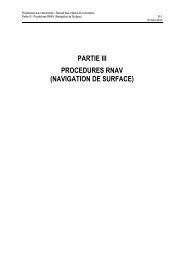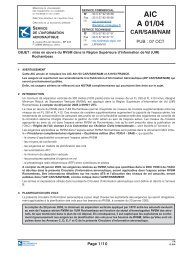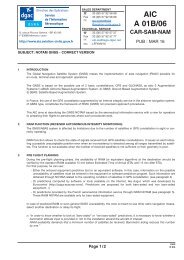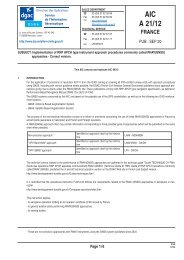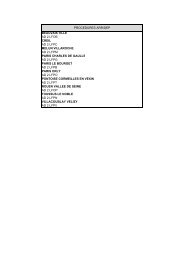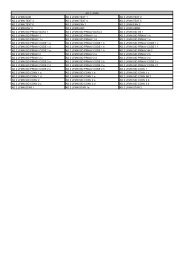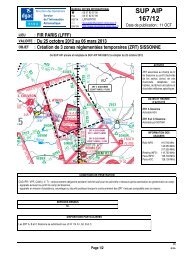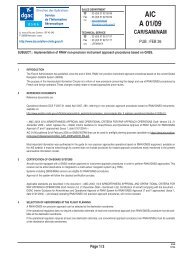Flight information with radar vizualisation - SIA
Flight information with radar vizualisation - SIA
Flight information with radar vizualisation - SIA
You also want an ePaper? Increase the reach of your titles
YUMPU automatically turns print PDFs into web optimized ePapers that Google loves.
The CRNA (Centre en Route de la Navigation Aérienne) in Brest, Marseille, and Paris are to provide a flight <strong>information</strong> service <strong>with</strong> <strong>radar</strong><br />
visualization in Class E and G airspace.<br />
The present AIC cancels and replaces AIC A 07/05.<br />
TECHNICAL SERVICE<br />
☎ : +33 (0)5 57 92 57 57<br />
Fax : +33 (0)5 57 92 57 77<br />
✉ : sia-direction@aviation-civile.gouv.fr<br />
Site <strong>SIA</strong> : http://www.sia.aviation-civile.gouv.fr<br />
SUBJECT : <strong>Flight</strong> <strong>information</strong> <strong>with</strong> <strong>radar</strong> <strong>vizualisation</strong><br />
1 INTRODUCTION<br />
The purpose of this aeronautical <strong>information</strong> circular is to inform users about the conditions which will apply in the Centres en Route de la Navigation<br />
Aérienne (Area Control Centres) <strong>with</strong>in the flight Information Centres (FIC) in Brest (FIC Brest), Marseille (FIC Marseille) and Paris (FIC Paris) the<br />
provision of a flight <strong>information</strong> service <strong>with</strong> <strong>radar</strong> visualization in Class E and G airspace.This provision does not concern <strong>Flight</strong> Information Sectors<br />
(FIS) and airspace managed by the approach control centres.<br />
2 SERVICE PROVIDED<br />
The flight <strong>information</strong> service <strong>with</strong> <strong>radar</strong> visualization is in line <strong>with</strong> Air Traffic Regulations - air traffic services (RCA/3) compliant <strong>with</strong> the provisions<br />
in Annex 11 of the ICAO regarding flight <strong>information</strong> service.<br />
This service is provided to aircraft pilots under visual flight rules (VFR) by FIC agents using a <strong>radar</strong> visualization tool which allows them to<br />
visualize VFR aircraft to which they assigned an transponder (SSR) code different from 7000.<br />
3 SCHEDULE AND FREQUENCIES<br />
Unless otherwise announced by NOTAM, the FIC schedules and frequencies are as follows:<br />
AIC FRANCE<br />
A 01/11<br />
Publication date: FEB 10<br />
FIC Frequencies Schedule UTC Telephone<br />
Brest 134.2 - 122.8 1 st April to 30 th September: 0645 to SS*+30 (MAX 1930) (33)2 98 37 34 36<br />
1 st October to 31 st March:<br />
SUM: 0700 to SS*+30 (MAX 1800)<br />
WIN: 0800 to SS*+30 (MAX 1900)<br />
* SS of Rennes Saint Jacques AD (LFRN)<br />
Marseille 124.5 - 120.550 SUM: 0700 to SS+30 (MAX 1800) (33)4 42 33 76 76<br />
WIN: 0800 to SS+30 (MAX 1700)<br />
Paris 125.7 - 129.625 SUM: 0700 to SS+30 (MAX 1900) (33)1 69 57 66 61<br />
- 126.1 WIN: 0800 to SS+30 (MAX 2000)<br />
4 REMIND: INFORMATION PROVIDED AS PART OF THE FLIGHT INFORMATION SERVICE WITHOUT RADAR VISUALIZATION<br />
The <strong>information</strong> provided on FIC frequencies includes:<br />
- meteorological <strong>information</strong> (TAF, METAR, etc.),<br />
- activities in restricted, dangerous, temporary segregated areas (TSA) or cross-border areas (CBA),<br />
- particular activities in progress such as military exercises,<br />
- ground equipment and infrastructure availability.<br />
5 INFORMATION PROVIDED AS PART OF THE FLIGHT INFORMATION SERVICE WITH RADAR VISUALIZATION<br />
Under the conditions stipulated in paragraph 6 of the present document, pilots in VFR flight can obtain the following supplementary <strong>information</strong>:<br />
a) <strong>information</strong> on the aircraft’s position, upon the pilot’s request;<br />
b) <strong>information</strong> as to the relative position of other aircraft known to the FIC agent, whenever it can help the pilot to anticipate a collision. This is<br />
upon the pilot’s request or upon the FIC agent’s initiative;<br />
Note: the aircraft known are principally those equipped <strong>with</strong> a transponder mode A + C or mode S level 2 at least <strong>with</strong> an alticoder,, for which<br />
the FIC has assigned a transponder code.<br />
c) <strong>information</strong> on the proximity of airspace subject to clearance, regulated areas or forbidden areas, upon the pilot’s request;<br />
d) assistance in entering airspace subject to clearance, upon the pilot’s request. In some cases the FIC will in fact obtain clearance for a controlled<br />
airspace subject to clearance before penetration of that airspace and will in turn pass it on to the pilot.<br />
Note: FIC agents are not able to give at each time the <strong>information</strong> in b), c) and d) above mentionned.<br />
ENG<br />
Page 1/2 © <strong>SIA</strong>
AIC N° 01/11<br />
6 CONDITIONS TO BE FULFILLED TO BENEFIT FROM THE ADDITIONAL INFORMATION PROVIDED AS PART OF THE FLIGHT INFORMATION<br />
SERVICE WITH RADAR VISUALIZATION<br />
In order to benefit from flight <strong>information</strong> provided by the FIC <strong>with</strong> <strong>radar</strong> visualization the following conditions apply:<br />
• the aircraft must be equipped <strong>with</strong> a transponder mode A + C (or mode S level 2 at least) <strong>with</strong> alticoder,<br />
• the pilot flying under VFR must:<br />
- At the first contact transmit to the FIC all flight data necessary for the supply of flight <strong>information</strong> <strong>with</strong> <strong>radar</strong> visualization to operate in the<br />
FIC area. This particularly includes the call sign, type of aircraft as well as the aerodrome of departure and arrival;<br />
- squawk the transponder code given to him by the FIC, to know the aircraft’s position in three dimensions;<br />
- maintain radio contact <strong>with</strong> the FIC using the frequencies defined in paragraph 3 above;<br />
The provision of a flight <strong>information</strong> service <strong>with</strong> <strong>radar</strong> visualization entails the acceptance by the pilot of these conditions.<br />
7 PILOT RESPONSIBILITY<br />
7.1 <strong>Flight</strong> planning – Prevention of collisions<br />
The provision of a flight <strong>information</strong> service <strong>with</strong> or <strong>with</strong>out <strong>radar</strong> visualization to an aircraft in VFR flight <strong>with</strong>in a Class E or G airspace does not free<br />
the captain from his entire responsibility for flight planning and piloting of his aircraft in any way whatsoever.<br />
The method for the prevention of collisions always consists of applying the “See And Avoid” rule in particular. The avoidance of forbidden areas, the<br />
obtaining of clearances or authorizations to operate in a controlled airspace or regulated area are the sole responsibility of the pilot.<br />
Within the context of the flight <strong>information</strong> service it should be noted that since the FIC only has partial knowledge of the traffic in Class E and G<br />
airspace, no manoeuvring suggestions will be made to pilots under VFR regarding the prevention of collisions.<br />
7.2 No coordination <strong>with</strong> adjacent FICs or SIVs<br />
After leaving the frequency of one FIC, the pilot can make radio contact <strong>with</strong> an adjacent FIC or SIV if he wishes, but it is his responsibility.<br />
7.3 Radio communications<br />
A pilot who is being provided the flight <strong>information</strong> service <strong>with</strong> <strong>radar</strong> visualization shall not leave the frequency <strong>with</strong>out first informing the FIC agent<br />
in order to avoid an unnecessary triggering of emergency phases.<br />
When the pilot frees the frequency, he also frees the specific transponder code assigned. If he does not receive a new code, he shall squawk 7000<br />
on his transponder.<br />
8 WARNING RELATED TO RADAR COVERAGE<br />
Depending on the route chosen by the pilot under VFR, it is possible that part or all of the flight takes place outside FIC <strong>radar</strong> coverage, notably at<br />
low altitude in mountainous regions which render the provision or continued provision of flight <strong>information</strong> based on <strong>radar</strong> <strong>information</strong> impossible.<br />
9 INTERRUPTION OF RADIO COMMUNICATIONS<br />
9.1 Warning related to radio coverage<br />
The pilot’s attention is drawn to the fact that for technical reasons, VHF radio coverage might not cover the whole of the flight <strong>information</strong> regions,<br />
especially at low altitude in remote maritime areas or in mountainous region.<br />
Reminder of the regulations in the event of radio communication failure<br />
The pilot is reminded that in the event of a failure in radio communications between an aircraft and an air traffic body, the pilot must notify the air<br />
traffic organisations as soon as possible after landing if an exchange of messages should have taken place or should have continued.<br />
10 ASSISTANCE<br />
Should a pilot declare having difficulties on the FIC frequency or display the code 7500 (unlawful interference), 7600 (communication failure) or 7700<br />
(emergency), an assistance will immediately be provided under the best possible conditions, regardless of any particular conditions connected <strong>with</strong><br />
the provision of the flight <strong>information</strong> service <strong>with</strong> <strong>radar</strong> visualization.<br />
ENG<br />
Page 2/2 © <strong>SIA</strong>





